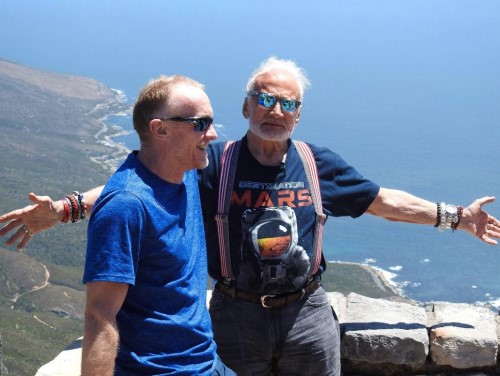South Pole 2016
I’ve always been fascinated by space ever since watching the moon landings with my dada back in July 1969. So, when an opportunity arose to join Buzz Aldrin, the Apollo 11 Lunar Module pilot and second man on the moon, in his quest to be the oldest person to the regular south Pole, I jumped at the chance.

The trip was positioned as a form of luxury travel in Antarctica, as opposed to a more serious expedition. We’d be staying at White Desert’s camp in Whichaway 70º 45’ 49” S 11º 36’ 59” E. We’d be sleeping in “pods” or domes buildings on an ice-free oasis next to a fresh water lake. The whole camp feels as if it is something on Mars, which further tied in with Buzz’s quest to get mankind exploring other planets.
The team assembled in Cape Town in late November 2016, before the flight out to Antarctica. Most of us arrived a day or so early and, as almost every visitor to Cape Town does, we decided to go up Table Top Mountain.
The vast majority of the group were happy to take the cable car up and down the mountain. But I quite fancied climbing up. There are around five or six recognised trails up Table Top Mountain all of which are fairly steep, rocky climbs. No ropes are needed for the 700m ascent, and you are advised to go with other people because the biggest danger is that of being mugged!
The only other ‘taker’ for the climb was Hamish Harding, another modern day explorer and aviation enthusiast. Sadly, most people now know Hamish as one of the five souls who lost their lives in the Titan submersible disaster on a descent to the Titanic.

Hamish Harding on Table Top Mountain
We took a Russian-built Ilyushin IL-76 out to the ice. The flight took about six hours and you don’t have windows in that aircraft. You are huddles together with scientific staff for the various bases in Antarctica and one hour before landing a screen declares “The Winter is coming”. That is a cue to get into your cold weather gear.
Once landed we transferred to Whichaway by Arctic Truck and pull-along wooden sled. That would be our home for the weeklong trip.
A good-weather window saw us setting off for the South Pole pretty much the next day. We transferred back to the blue ice runway and boarded a Bassler BT-67 is a versatile and durable aircraft that is able to land on snow and ice.
The flight is in two stages. First there’s a five-hour flight to FD-83, which is a Fuel Dump at 83 degrees south, now known as Dixie Camp. Followed by another three hours to the South Pole runway.
Something important to note here is that the South Pole is at an altitude of 2,835 metres which is around the same as most top stations in alpine ski resorts, just because of the thickness of ice. This high altitude and lower air pressure makes it feel as if there is less oxygen and can cause low oxygen saturation levels or desaturation of an individual's blood.
As we were coming into land, Patrick Woodhead, a founder of White Desert explained there are five South Poles:
- The research base calls itself the South Pole
- A ceremonial South Pole surrounded by 12 flags of nations that signed the original Antarctic Treaty
- The South Pole about which the world is rotating.
- The Geomagnetic South Pole, and
- The Southern Pole of Inaccessibility.
I’d never heard of Poles of Inaccessibility at that time and little did I know it would become one of my main targets in life to visit all eight such poles.
The South Pole Station is a US Scientific Research Station, and they don’t usually allow ‘tourists’ or regular Antarctic adventurers inside except in case of medical emergency. But that was one of the advantages of travelling with a US National Hero in Buzz. Not only were we allowed inside but we were given a full tour of the base.
It was during this tour that Buzz fell ill with the aforementioned low oxygen level in his blood. This would eventually see him hospitalised at the base, then spend another week or so at McMurdo before being medevacked out via New Zealand.
Being in capable hands, I took the opportunity to go out and visit both the ceremonial south pole and the actual south pole for 2016. And at the latter, I took the chance to run right round the world in under five seconds!

At the ceremonial South Pole
